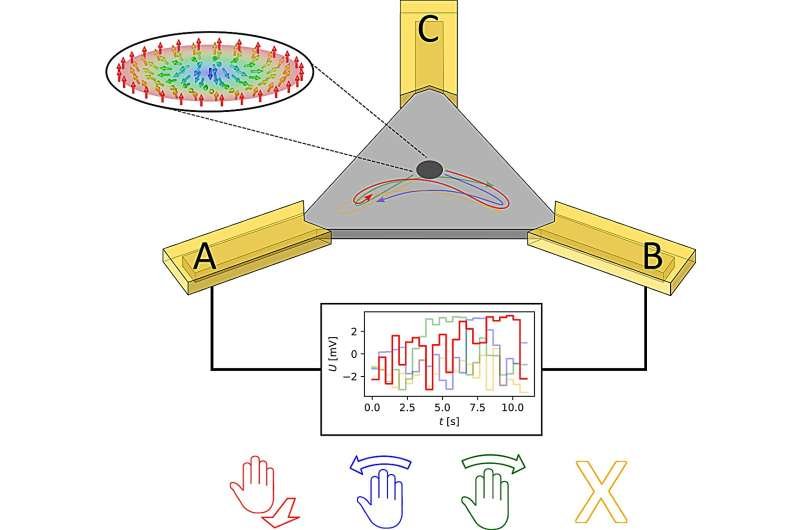The Daily Observer London Desk: Reporter- John Furner
Researchers at Johannes Gutenberg University Mainz (JGU) have managed to enhance the framework of Brownian reservoir computing by recording and transferring hand gestures to the system that then used skyrmions to detect these individual gestures.
“We were impressed to see that our hardware approach and concept worked so well—and even better than energy-intensive software solutions that employ neural networks,” said Grischa Beneke, a member of Professor Mathias Kläui’s research group at the JGU Institute of Physics.
In collaboration with other experimental and theoretical physicists, Beneke was able to demonstrate that simple hand gestures can be recognized by means of Brownian reservoir computing with a relatively high degree of precision.
The work is published in the journal Nature Communications.
Reservoir computing requires no training efforts and reduces energy consumption
Reservoir computing systems are similar to artificial neural networks. Their advantage is that they do not need extensive training, which reduces their overall energy consumption. “All we have to do is train a simple output mechanism to map the result,” explained Beneke.
The exact computing processes remain unclear and are not important in detail. The system can be compared to a pond in which stones have been thrown, creating a complex wave pattern on the surface. In the same way that the waves hint to the number and position of stones thrown, the output mechanism of the system provides information on the original input.
In the paper, the researchers describe how they recorded simple hand gestures such a swipe left or right with Range-Doppler radar, employing two Infineon Technologies radar sensors. The radar data is then converted into corresponding voltages to be fed into the reservoir that, in this case, consists of a multilayered thin film stack of various materials that is formed into a triangle with contacts at each of its corners.
Two of the contacts supply the voltage, which causes the skyrmion to move within the triangle. “In reaction to the supplied signals, we detect complex motions,” described Grischa Beneke. “These movements of the skyrmion enable us to deduce the movements that the radar system has recorded.”
Skyrmions are chiral magnetic whirls that are considered to have major potential for use in non-conventional computing devices and as information carriers in innovative data storage devices.
“Skyrmions are really astonishing. We first regarded them only as candidates for data storage but they also have great potential for applications in computing combined with sensor systems,” emphasized Professor Mathias Kläui, supervisor of this field of research at JGU.
Comparison of the results obtained using Brownian reservoir computing with those recorded using a software-based approach shows that the accuracy of gesture recognition is similar or even better in the case of Brownian reservoir computing. The benefit of the combination of reservoir computing with a Brownian computing concept is that skyrmions are free to perform random motions because local differences in magnetic properties have less influence on how they react.
This means that skyrmions, in contrast with how they usually respond, can be made to move with just very low currents—which demonstrates a significant improvement in energy efficiency in comparison with the software approach.
As the data collected by the Doppler radar and the intrinsic dynamics of the reservoir operate on similar time scales, the sensor data can be input directly into the reservoir. The time scales of the system can be adapted to resolve a variety of other problems.
“We find that the radar data of different hand gestures is detected in our hardware reservoir with a fidelity that is at least as good as a state-of-the-art software-based neural network approach,” the researchers concluded.
According to Beneke, further improvement should be possible in terms of the read-out process, which currently uses a magneto-optical Kerr-effect (MOKE) microscope. The employment of a magnetic tunnel junction instead could help to reduce the size of the whole system. The signals provided by a magnetic tunnel junction are already being emulated to demonstrate the capacity of the reservoir.



